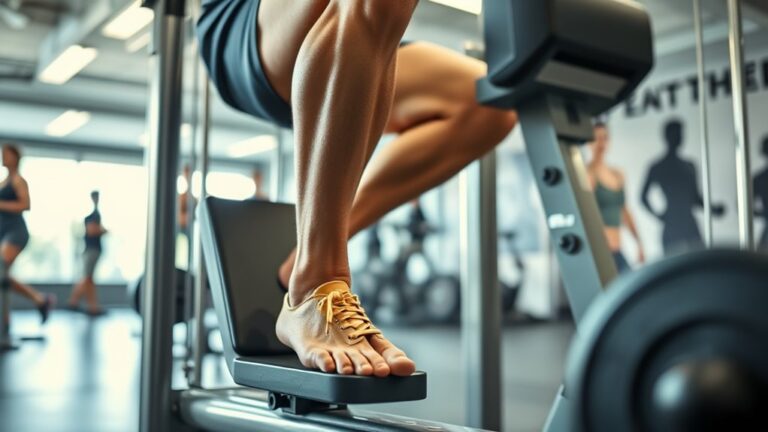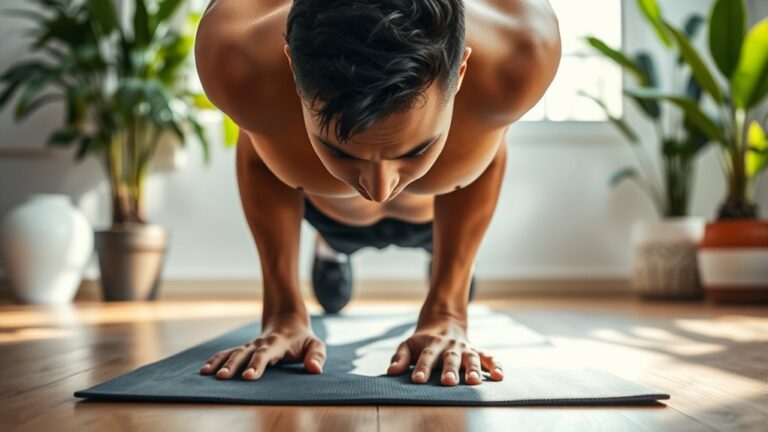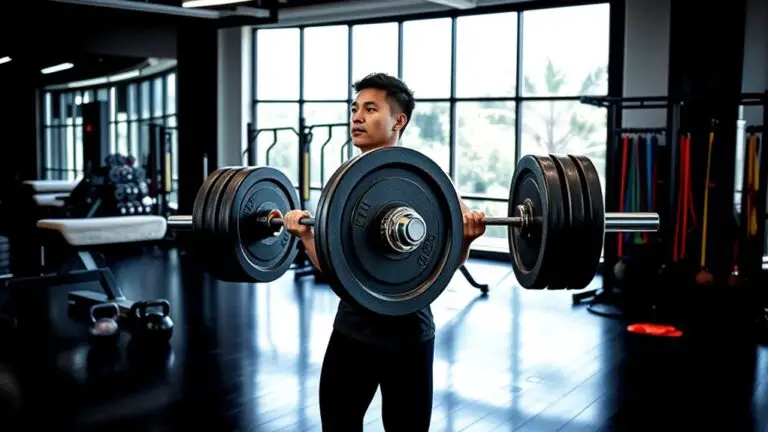How to Build a Bigger Chest Without Heavy Weights

To build a bigger chest without heavy weights, focus on bodyweight exercises like push-ups, decline push-ups, and dips. Use resistance bands for chest presses and flys to target different parts of your pecs. Everyday objects like backpacks filled with books or water bottles can add resistance too. Incorporating plyometric movements like clap push-ups can further enhance your strength. Prioritize proper form and technique for injury prevention. Continue to explore more strategies for effective chest development.
Understanding the Pectoral Muscles
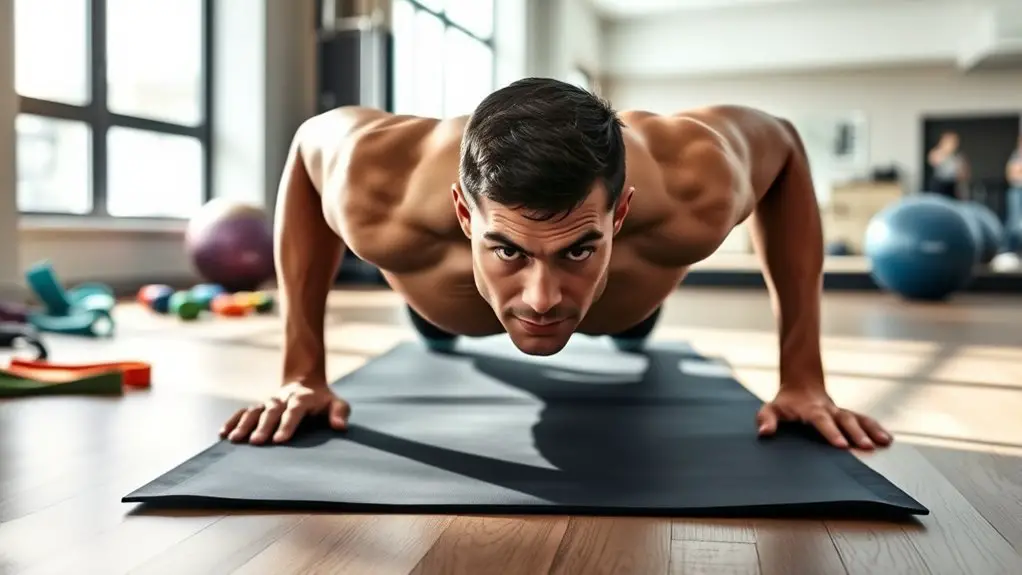
The pectoral muscles, often referred to as the “pecs,” play an essential role in upper body strength and aesthetics. Understanding their anatomy overview is vital for anyone looking to enhance their chest while prioritizing safety. The pecs consist of two main parts: the pectoralis major and the pectoralis minor. The pectoralis major is the larger muscle, responsible for movements like pushing and lifting. The pectoralis minor, located beneath the major, assists in stabilizing the shoulder.
When it comes to muscle function, the pecs help in activities such as lifting your arms and pushing objects away from your body. Engaging these muscles properly can lead to improved strength, posture, and overall performance. Always remember to warm up before exercising and listen to your body to avoid injuries. With this knowledge, you can work towards building a stronger chest while keeping safety in mind.
Bodyweight Exercises for Chest Development
Building strength in your pectoral muscles can be effectively achieved through bodyweight exercises, which require no equipment and can be done anywhere. These exercises not only enhance muscle growth but also guarantee safety by minimizing injury risks. Here are some effective options:
Building pectoral strength through bodyweight exercises is safe, effective, and requires no equipment.
- Standard Push-Ups: Great for overall chest activation.
- Decline Push-Ups: Elevate your feet to target the upper chest.
- Isometric Holds: Hold the push-up position at the bottom for increased time under tension.
- Wide-Grip Push-Ups: Position your hands wider apart to emphasize the outer chest.
Incorporating these push-up variations and isometric holds into your routine can considerably improve chest development. Remember to maintain proper form and listen to your body, adjusting as needed to prevent strain. With consistency and dedication, you’ll see results without the need for heavy weights.
Utilizing Resistance Bands
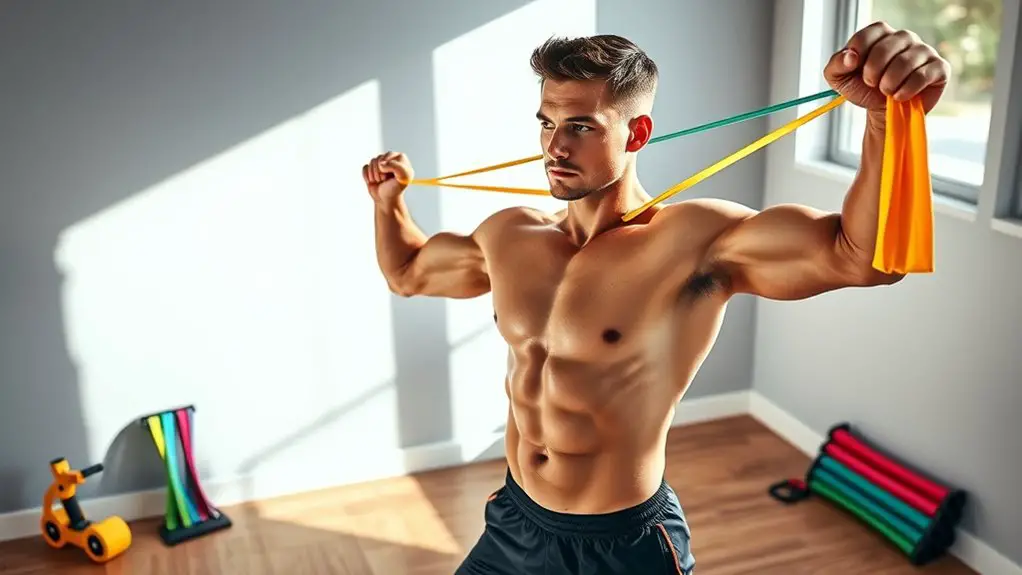
Resistance bands are a fantastic tool for enhancing your chest workouts. You can incorporate exercises like the band chest press and various resistance fly variations to really target those muscles. Let’s explore how to effectively use these bands for maximum chest development.
Band Chest Press
Whether you’re at home or in the gym, incorporating a band chest press into your routine can greatly enhance your upper body strength. This exercise allows for band tension and resistance variation, making it a fantastic alternative to heavy weights. Here’s how to do it safely:
- Secure the band behind you at chest height.
- Hold the handles, pressing forward while keeping your elbows slightly bent.
- Maintain a controlled motion to avoid injury.
- Adjust the band tension for your fitness level, ensuring it feels challenging but safe.
Resistance Fly Variations
When it comes to developing your chest, incorporating resistance fly variations with bands can make a significant difference. These exercises help target your pectoral muscles while minimizing the risk of injury common with heavy weights. Start by anchoring the band behind you, then extend your arms out to the sides and bring them together in front of your chest, keeping a slight bend in your elbows. You can also try different angles, like performing incline or decline fly variations, to engage different areas of your chest. Remember to control your movements and focus on form during resistance training, which enhances your muscle connection and overall effectiveness. Adding these fly variations can help you achieve a bigger chest safely and efficiently.
Everyday Objects as Workout Tools
You don’t need fancy gym equipment to build a bigger chest; your home is full of potential workout tools. From using a sturdy chair for dips to grabbing milk jugs for added resistance, everyday items can enhance your routine. Let’s explore how you can get creative with bodyweight exercises and household objects.
Household Items for Resistance
Finding effective workout tools doesn’t have to mean investing in expensive gym equipment. You can use common household items for resistance training, ensuring safety while effectively building your chest. Here are some everyday objects to take into account:
- Canned goods: Use these as light weights for chest presses or flys.
- Backpack: Fill it with books to add weight for push-ups or planks.
- Sturdy chair: Utilize it for incline or decline push-ups to target different chest areas.
- Water bottles: Fill them up for easy-to-handle weights during various exercises.
Creative Bodyweight Exercises
Creative bodyweight exercises can be just as effective as traditional weights, especially when you incorporate everyday objects into your routine. You can use sturdy items like a backpack filled with books or a chair to perform push-ups and dips. These exercises engage your chest while ensuring safety if done correctly.
Don’t forget to include chest stretching after your workout to promote muscle recovery and flexibility. For instance, leaning against a wall while stretching your arms can open up your chest and enhance mobility. Remember to listen to your body; if something feels off, stop and adjust your form. By creatively utilizing what you have at home, you can build a bigger chest safely and effectively without heavy weights.
Incorporating Plyometric Movements

While traditional strength training is essential for building a bigger chest, incorporating plyometric movements can elevate your workout by adding explosive power and enhancing muscle engagement. These dynamic exercises not only challenge your upper body but also improve overall athleticism. Here are some effective plyometric movements to take into account:
- Plyometric Push Ups: Push off the ground with enough force to lift your hands, landing softly.
- Clap Push Ups: Similar to plyometric push ups, but add a clap in between for an extra challenge.
- Medicine Ball Chest Pass: Explosively throw a medicine ball against a wall or to a partner, focusing on your chest engagement.
- Explosive Chest Press: Use resistance bands to push forward with explosive strength.
Remember to maintain control and focus on your form. Start slow, progress gradually, and make sure you’re ready for the intensity of these explosive chest exercises.
The Importance of Proper Form and Technique
Proper form and technique are essential when building a bigger chest, as they not only maximize your gains but also help prevent injuries. When you’re performing chest exercises, focus on maintaining proper alignment. This means keeping your shoulders back, chest up, and core engaged throughout the movement. By doing so, you guarantee that the right muscles are being targeted, preventing strain on your joints.
Effective muscle engagement is key. Before you start each rep, visualize the muscles you want to work and concentrate on activating them. This way, you’ll get more out of each exercise and reduce the risk of overexerting yourself or using momentum. Remember, it’s better to perform fewer reps with proper form than to rush through more reps and sacrifice technique. Prioritizing form will lead to better results and a safer workout experience, allowing you to build that bigger chest without the risk of injury.
Creating a Balanced Chest Workout Routine
Building a bigger chest isn’t just about exercising; it’s about having a well-rounded routine that targets all areas of the chest. To achieve this, you need to incorporate various movements that enhance your chest workout while ensuring safety and effectiveness. Here are some key components to include:
Building a bigger chest requires a balanced routine that targets all areas for optimal strength and development.
- Upper Chest Focus: Use incline push-ups or resistance bands to target the upper region.
- Mid Chest Strength: Perform standard push-ups or flat bench variations for balanced development.
- Lower Chest Emphasis: Incorporate decline push-ups or dips to work the lower portion effectively.
- Exercise Progression: Gradually increase difficulty by modifying angles or adding resistance to keep challenging your muscles safely.
Frequently Asked Questions
How Long Does It Take to See Results From These Exercises?
Well, if you’re expecting results overnight, you might as well wish for a unicorn! Generally, you’ll start seeing changes in about 4 to 6 weeks, but it really depends on your exercise frequency and workout consistency. If you’re committed to a safe routine and keep at it, those gains will come. Remember, patience is key—your chest isn’t going to grow while you’re binge-watching your favorite show! So, keep it up!
Can I Build Muscle Without Protein Supplements?
Yes, you can definitely build muscle without protein supplements! Focus on dietary sources like lean meats, beans, nuts, and dairy, which provide the essential nutrients your body needs. Remember, muscle recovery is vital, so make sure you’re getting enough protein from your meals. A balanced diet rich in whole foods can support your goals just as effectively. Just listen to your body, and give it the nutrients it craves for the best results.
Is It Safe to Workout Every Day?
Did you know that about 70% of people who workout daily don’t allow for proper recovery? It’s essential to balance daily workouts with adequate workout recovery to prevent injury. While some can safely exercise every day, it often depends on your fitness level and the intensity of your workouts. Listen to your body; if you’re feeling fatigued or sore, it’s wise to take a rest day to guarantee safety and effectiveness.
Should I Stretch Before or After My Workout?
You might be wondering whether you should stretch before or after your workout. It’s best to incorporate dynamic stretching before your workout to warm up your muscles and increase blood flow, which helps prevent injuries. After your workout, static stretching can be beneficial for improving flexibility and aiding recovery. Just remember to listen to your body—if something doesn’t feel right, don’t push it. Safety should always come first in your fitness routine!
How Do I Maintain Motivation for My Workouts?
Maintaining motivation for your workouts can be challenging, but goal setting’s key. Start by setting realistic, achievable goals that excite you. Incorporating workout variety keeps things fresh and prevents boredom, so mix up your routine with different exercises or activities. Also, consider finding a workout buddy or joining a class for added support and accountability. Remember, it’s important to listen to your body and prioritize safety as you endeavor to achieve your fitness goals.
